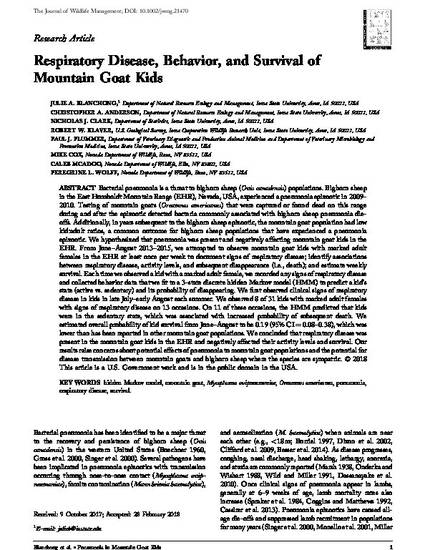
Bacterial pneumonia is a threat to bighorn sheep (Ovis canadensis) populations. Bighorn sheep in the East Humboldt Mountain Range (EHR), Nevada, USA, experienced a pneumonia epizootic in 2009–2010. Testing of mountain goats (Oreamnos americanus) that were captured or found dead on this range during and after the epizootic detected bacteria commonly associated with bighorn sheep pneumonia die‐offs. Additionally, in years subsequent to the bighorn sheep epizootic, the mountain goat population had low kid:adult ratios, a common outcome for bighorn sheep populations that have experienced a pneumonia epizootic. We hypothesized that pneumonia was present and negatively affecting mountain goat kids in the EHR. From June–August 2013–2015, we attempted to observe mountain goat kids with marked adult females in the EHR at least once per week to document signs of respiratory disease; identify associations between respiratory disease, activity levels, and subsequent disappearance (i.e., death); and estimate weekly survival. Each time we observed a kid with a marked adult female, we recorded any signs of respiratory disease and collected behavior data that we fit to a 3‐state discrete hidden Markov model (HMM) to predict a kid's state (active vs. sedentary) and its probability of disappearing. We first observed clinical signs of respiratory disease in kids in late July–early August each summer. We observed 8 of 31 kids with marked adult females with signs of respiratory disease on 13 occasions. On 11 of these occasions, the HMM predicted that kids were in the sedentary state, which was associated with increased probability of subsequent death. We estimated overall probability of kid survival from June–August to be 0.19 (95% CI = 0.08–0.38), which was lower than has been reported in other mountain goat populations. We concluded that respiratory disease was present in the mountain goat kids in the EHR and negatively affected their activity levels and survival. Our results raise concerns about potential effects of pneumonia to mountain goat populations and the potential for disease transmission between mountain goats and bighorn sheep where the species are sympatric.
Available at: http://works.bepress.com/paul-plummer/34/

This article is published as Blanchong, Julie A., Christopher A. Anderson, Nicholas J. Clark, Robert W. Klaver, Paul J. Plummer, Mike Cox, Caleb Mcadoo, and Peregrine L. Wolff. "Respiratory disease, behavior, and survival of mountain goat kids." Journal of Wildlife Management. (2018). DOI: 10.1002/jwmg.21470. Posted with permission.